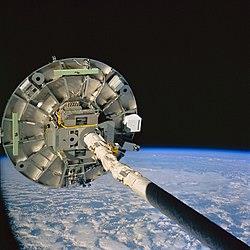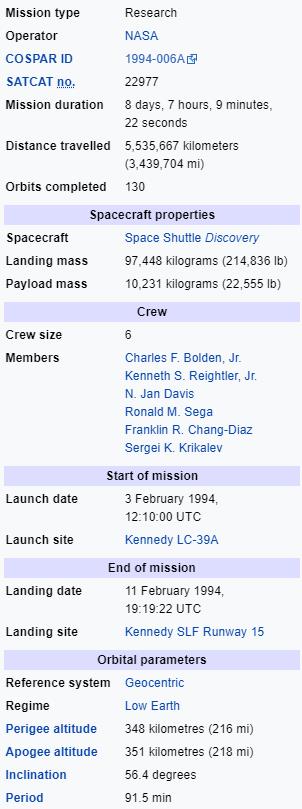Charles F. Bolden
(Fourth Space Flight)
Kenneth S. Reightler Jr.
(Second Space Flight) Mission Specialist 1:
N. Jan Davis
(First Space Flight) Mission Specialist 2:
Ronald M. Sega
(Fourth Space Flight) Mission Specialist 3:
Franklin R. Chang-Diaz
(Third Space Flight) Mission Specialist 4:
Sergel K. Krikalev, RKA
(Second Space Flight)
STS-60 was the first mission of the US/Russian Shuttle-Mir Programme, which carried Sergei K. Krikalev, the first Russian cosmonaut to fly aboard a Space Shuttle. The mission used Space Shuttle Discovery, which lifted off from Launch Pad-39Aon 3 February 1994 from Kennedy Space Centre, Florida. The mission carried the Wake Shield Facility experiment and a SPACEHAB module into orbit, and carried out a live bi-directional audio and downlink link-up with the cosmonauts aboard the Russian space station Mir.
A free template by Lucknowwebs.com for WYSIWYG WebBuilder 8
Study
Research
Main Index
Space Cosmology
Science Research
*
About
Science Research
Science Theories
Desk
Site Map
BookShelf
Copyright © by Nigel G Wilcox · All Rights reserved · E-Mail: ngwilcox100@gmail.com
Designed by Nigel G Wilcox
Powered By AM3L1A
Pages within this section: USA Shuttle Mission Flights
STS-60
Pages within this section:
The Space Shuttle Missions
Astronauts:
STS-60
Command Pilot:
Pilot:
53
M
8
SM
Sub-Menu
menu
-
54
55
56
57
58
59
60
After External Tank separation and main engine cutoff, a 2.5 min OMS burn was initiated at 7:52 am EST that circularized Discovery's orbit from a 40 by 190 nautical mile (74 by 352 kilometres (219 mi)) orbit to 190 by 190 nautical miles (353 by 352 kilometres (219 mi)). Shortly after liftoff, pilot Kenneth S. Reightler Jr. experienced problems with his portable headset. The problem was traced to the Headset Interface Unit (HIU) and that unit was swapped with a flight spare. The payload bay doors were opened and around 8:45 am EST the crew was given a go for on-orbit operations.
Shortly after reaching orbit, the STS-60 crew began checking Discovery's systems and activating the commercially developed SPACEHAB laboratory module and several of its experiments. The crew also activated one group of the payload bay Getaway Special experiments.
SPACEHAB module experiments that were activated included the Organic Separations payload, which is designed to investigate cell separation techniques for possible pharmaceutical and biotechnology processing, and the Equipment for Controlled Liquid Phase Sintering Experiment package, a furnace designed to explore the possibilities of creating stronger, lighter and more durable metals for use in bearings, cutting tools and electronics. SPACEHAB middeck experiments that were activated included Immune-1, which will look at the immune systems of rats in orbit, and the Commercial Protein Crystal Growth package, which is attempting to grow large, well- ordered protein crystals so that their structures can be more easily studied. The crew sleep period then began at 6:10 pm EST.
At 6:30 am EST on 5 February 1994 Discovery inadvertently flew through a cloud of wastewater ice crystals. Flight controllers determined that approximately one tablespoon of wastewater leaked out of a waste dump nozzle.
The Wake Shield Facility deployment operation was canceled on Saturday. This delay was the result of several factors, including radio interference and an inability to read the Wake Shield's status lights when the orbiter's payload bay is in full sunlight. Deployment originally was scheduled for 10 am CST, but after grappling the free-flyer and lifting it out of the cargo bay and into the pre-deploy position, crew members and investigators on the ground were unable to tell whether power and transmitter status lights were giving the proper indications. After determining that the problem was not a systems failure, but difficulty in reading the status lights, the crew and flight controllers prepared for another release attempt. Interference between the radio transmitter on the Wake Shield Facility and the receiver on its payload bay carrier resulted in a one-day delay.
Wake Shield deployment was also cancelled on Sunday, 6 February 1994 during its orbit 53 opportunity at 12:25 pm WSF and flight controllers worked on problems with the Pitch and Roll sensors on WSF's Attitude, Direction and Control system. Astronaut N. Jan Davis moved the wrist joint on the Remote Manipulator System (RMS) arm to try to point WSF's Horizon Sensor into the Sun in an attempt to warm up the sensor's electronics package. The last deployment opportunity for Sunday was a 50-minute window beginning at 2:23 EST on orbit 54 but WSF was not ready. It was left mounted on the RMS during the crew sleep period while ground controllers considered their options. On its perch at the end of the RMS over night, WSF was able to grow 2 Gallium Arsenide (GaAs) thin films. The next deployment opportunity on 7 February 1994 would have been during orbit 67 but payload controllers and flight controllers determined that there would be insufficient time to safely develop contingency procedures in the event that WSF was unable to maintain stable attitude control without the use of its Horizon Sensor. It was decided that for the remainder of the mission, all WSF operations would take place at the end of the RMS and there would be no WSF free-flying operations on the mission.

The Wake Shield Facility grappled by the RMS
Data Courtesy Wikipedia.org















